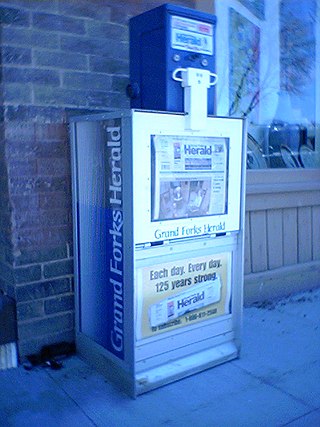
The Grand Forks Herald is a daily broadsheet newspaper, established in 1879, published in Grand Forks, North Dakota, United States. It is the primary daily paper for northeast North Dakota and northwest Minnesota. Its average daily circulation is approximately 7,500, in the city of Grand Forks plus about 7,500 more to the surrounding communities. Total circulation includes digital subscribers. It has the second largest circulation in the state of North Dakota.

Fargo Station is a train station in Fargo, North Dakota, United States. It is served by Amtrak's Empire Builder. It is the only railway station in use in the Fargo-Moorhead area and is the third-busiest in North Dakota. The platform, tracks, and station are currently all owned by BNSF Railway. The station is currently located in the former BNSF freight house. The former main station building is now home to Great Northern Bicycle Co.

This is a list of the National Register of Historic Places listings in Grand Forks County, North Dakota. This is intended to be a complete list of the properties and districts on the National Register of Historic Places in Grand Forks County, North Dakota, United States. The locations of National Register properties and districts for which the latitude and longitude coordinates are included below, may be seen in an online map.
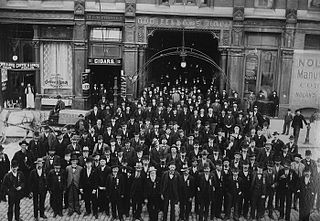
The Ancient Order of United Workmen (AOUW) was a fraternal organization in the United States and Canada, providing mutual social and financial support after the American Civil War. It was the first of the "fraternal benefit societies", organizations that would offer insurance as well as sickness, accident, death and burial policies.

This is a list of the National Register of Historic Places listings in Cass County, North Dakota.
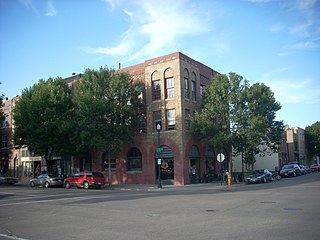
The Odd Fellows Block, located at 23-25 S 4th st and 324 Kittson Ave in the Downtown Grand Forks Historic District of Grand Forks, North Dakota is a historic building built in 1888 as a home for the Odd Fellows meeting hall, which was situated on the third floor. The hall was fitted with a large and well-appointed lodge room, a banquet hall, and numerous smaller rooms.

The Thomas D. Campbell House is a historic Gothic Revival style log and wood frame home located in Grand Forks, North Dakota. It is significant for its association with Thomas D. Campbell, who became the largest wheat farmer in the United States. It is part of the Myra Museum and is listed on the National Register of Historic Places.

The Grand Lodge of North Dakota, formally known as the Grand Lodge of Ancient, Free & Accepted Masons of North Dakota, is the governing body of the largest group of masonic lodges in North Dakota. It follows the Anglo-American tradition of Freemasonry common in the United States.

The Masonic Block in Fargo, North Dakota, also known as Dakota Business College or Watkins Block, is an Early Commercial style building built in 1884. It was designed by Fargo architects Daniels & Proctor.

The Ancient Order of Hibernians Hall, also known as Hibernian Hall, was a historic building in Anaconda, Montana, United States, that is listed on the National Register of Historic Places.
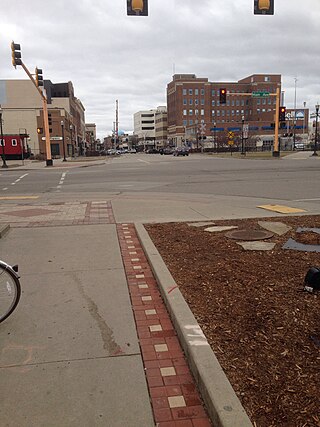
Downtown Fargo District, or Downtown Fargo Historic District, is a historic district in Fargo, North Dakota that was listed on the National Register of Historic Places in 1983.

The Grand Lodge and Library of the Ancient Free and Accepted Masons in Sioux Falls, South Dakota is a building from 1924. It was listed on the National Register of Historic Places in 1976. The architects were Hugill & Blatherwick of Sioux Falls.
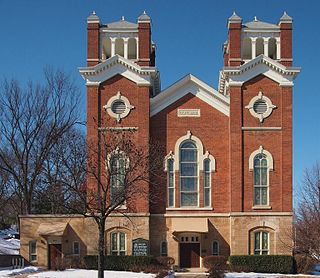
Charles N. Daniels (1828-1892) was an American architect active in Minnesota, North Dakota, and Washington.

The New Glarus Town Hall in New Glarus, Wisconsin, was built in 1886 to house both the town hall and a meeting place for the Ancient Order of United Workmen. It was added to the National Register of Historic Places in 2008.

The Perry and Brainard Block, also known as the North Des Moines Town Hall, is a historic building located in Des Moines, Iowa, United States. The structure was built between 1888 and 1889 and the second floor served as the city hall for the suburb of North Des Moines. In the late 19th century Des Moines actively sought to annex its Victorian suburbs, with North Des Moines being the largest of these communities. This is the only known public building that has survived from the Annexation Movement era. The local government and community of North Des Moines debated annexation, not only of the municipalities, but of their schools as well. It was also the only community where the residents voted on the annexation issue, and this building also served as a polling place. The building served as the location of the celebration after the referendums passed in 1890. After its use as the city hall, the second floor became the lodge for the Ancient Order of United Workmen.

Haxby & Gillespie was an architectural firm from Fargo, North Dakota. R. J. Haxby and William D. Gillespie were the partners. The firm "produced a number of important buildings throughout North Dakota." They designed many notable public, educational, commercial, and church buildings, in North Dakota, Minnesota, and Montana.

The Ancient Order of United Workmen Temple, also known as the Tourny Building, was a historic building located at the intersection of Southwest 2nd Avenue and Taylor Street in Portland, Oregon, in the United States. The six-story building was completed in 1892 and it was demolished in 2017 to be replaced by new development. Demolition was underway in August 2017, and it was complete by November of the same year.

The Black Building at 114-118 Broadway in Fargo, North Dakota was a "pivotal" historic resource in the Downtown Fargo District, in the listing of that historic district upon the National Register of Historic Places. In 2016 it was also individually listed on the National Register, as its "owners chose to pursue the honor of individual listing for its architecture and for its association with George Mumford Black and his strategies in commerce and communications. Black had the upper floor of the Art Moderne building designed for WDAY (AM) radio and ensured the station signed off each show with “this is WDAY with from the Black Building, Fargo” and he is credited with creating the one-cent sale."





















